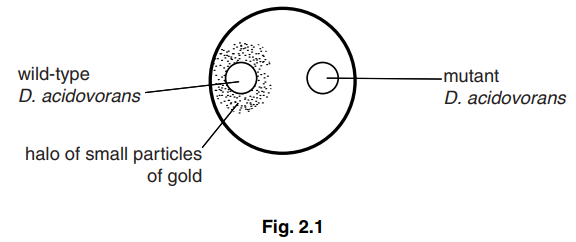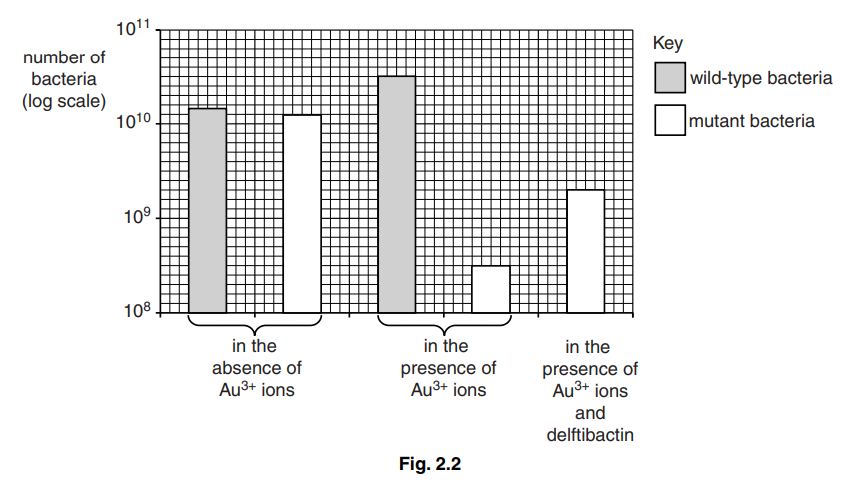Question
Gold ions (Au3+) are toxic to most microorganisms. However, the bacterium Delftia acidovorans is frequently found in sticky layers, called biofilms, that form on the surface of gold deposits.
D. acidovorans produces a peptide synthase that catalyses the synthesis of a small peptide called delftibactin. When isolated, delftibactin can precipitate Au3+ ions as small particles of metallic gold. Delftibactin is a secondary metabolite.
(a) Name another example of a secondary metabolite and explain what is meant by the term.[3]
example
explanation
(b) A mutant strain of D. acidovorans has been identified in which the gene coding for peptide synthase is inactive.
The wild-type (normal) and mutant D. acidovorans were grown on agar plates and then flooded with gold chloride solution, which contains Au3+ ions. The appearance of such a plate after this treatment is shown in Fig. 2.1.

With reference to Fig. 2.1, suggest how delftibactin protects D. acidovorans from toxic Au3+ ions.[3]
(c) Wild-type and mutant D. acidovorans were grown in standardised conditions:
- wild-type and mutant bacteria were grown in the absence of Au3+ ions
- wild type and mutant bacteria were grown in the presence of Au3+ ions
- mutant bacteria were grown in the presence of Au3+ ions and of delftibactin.
The results are shown in Fig. 2.2.

Explain whether or not the results shown in Fig. 2.2 support the idea that delftibactin is protective.[4]
(d) The secondary metabolite, delftibactin, could be used to remove the toxic Au3+ ions that are present in the waste produced by gold mining.
Describe how delftibactin could be produced on a large scale.[5] [Total: 15]
Answer/Explanation
Ans:
2 (a) example:
penicillin/ other named antibiotic ;
explanation any two from:
substance made by a microorganism during stationary phase/AW ;
A growth of microorganism has almost stopped
produced, when there is a shortage of nutrients /when population is under stress ;
not needed for normal metabolism (of microorganism) ;
(b) 1 wild-type bacteria, secretes /releases, delftibactin ; I produces
2 delftibactin makes soluble gold ions into insoluble gold ; A precipitates gold
3 insoluble gold is not toxic ; ora
4 insoluble gold, stays outside the bacteria/ not in bacterial cytoplasm ;
5 (so) no/ fewer, soluble gold ions enter bacterium (from solution) ;
A D. acidovorans for wild-type
A Au / metallic gold/ solid/ gold particles / gold precipitate for insoluble gold
A Au3+ / gold ions / ions for soluble gold
(c) 1 without Au3+ numbers of wild-type and mutants similar/AW ;
support
2 with Au3+ fewer mutants than wild-type ; ora
3 with Au3+ fewer mutants than without Au3+ ; ora
4 with Au3+ and (added) delftibactin more mutants than with Au3+ alone ; ora
does not support
5 with Au3+ and (added) delftibactin fewer mutants than without Au3+ ; ora
6 only one set of data /no statistical analysis ; A no repeats
(d) 1 grow the wild-type, bacterium/D. acidovorans ;
2 in fermenter ;
3 ref. to (fed) batch culture ;
4 ref. to sterilised ;
5 nutrients at start (batch)/ nutrients at intervals (fed) ;
6 carbon/ nitrogen, sources ;
7 ref. to aeration/ provide oxygen ;
8 ref. to constant temperature/water jacket ; A environmental conditions kept constant
9 details of fermenter ; e.g. paddles / stirrers
10 harvest delftibactin/ downstream processing ;
Question
(a) Explain the use of genes for fluorescent or easily stained substances as markers in gene technology. [6]
(b) Discuss the potential advantages of growing genetically modified crops, using examples to help your answer. [9] [Total: 15]
Answer/Explanation
Ans:
9 (a) 1 emits bright light ;
2 when exposed to UV light ;
3 visible colour change ;
4 add marker gene to the, vector/ plasmid ;
5 easy to identify transformed bacteria ;
6 gene of interest inserted, into/ close to, marker gene ;
7 easy to identify recombinant, DNA/ plasmid ;
8 easy to identify transgenic organisms ;
9 examples ; e.g. GFP/ β galactosidase/GUS
10 idea of no known risk ;
(b) 1 increase, food production/ crop yields ;
2 improve food, quality / taste/ keeping properties ;
3 add nutrients to crop (to improve human health) ;
4 crops may be more tolerant to climate change ;
5 crops, can be grown in poor quality land/ do not need as much fertiliser ;
6 pest/insect/ fungal disease, resistance (increases crop growth) ;
7 less pesticide used ;
8 benefit to farmer ; e.g. cost effective / health benefit
9 benefit to environment ; e.g. less effect on food chains, pollinators
10 herbicide resistance reduces competition from weeds ;
11 could engineer nitrogen-fixing ability in non-leguminous crops ;
12 specific examples (crop variety and enhancement described) ; ;
+ e.g. Golden Rice™ for extra vitamin A
13 Bt maize /Bt cotton, kill (named) leaf-eating insects
Flavr Savr tomato, stores better/ can ripen on vine
Question
Malaria is a serious and often fatal infectious disease caused by Plasmodium. Drugs such as chloroquine are widely used to decrease the risk of getting malaria and also to treat people who have become infected. However, in many parts of the world, Plasmodium populations have become resistant to chloroquine.
Sequencing the genome of Plasmodium and the application of bioinformatics has provided several new targets for the development of anti-malarial drugs.
(a) (i) Define the term bioinformatics.[2]
(ii) Outline how sequencing the genome of Plasmodium and the use of bioinformatics can suggest new targets for anti-malarial drugs.[3]
(b) In parts of the world where Plasmodium is resistant to chloroquine, one of the most effective anti-malarial drugs currently in use is artemisinin. Artemisinin works by binding to an enzyme in Plasmodium called PfATP6, acting as an inhibitor.
A substance called curcumin, which has long been used as a spice and yellow food colouring in India and other countries, is also known to act against chloroquine-resistant Plasmodium. A group of researchers predicted that curcumin acts by binding to the same enzyme as artemisinin.
In order to test this hypothesis, and to try to find similar substances that might work even better than curcumin, the researchers used theoretical modelling to:
- look at the chemical structures of various molecules with a similar structure to curcumin (curcumin analogues)
- generate a three-dimensional model of the structure of the enzyme PfATP6
- investigate whether each curcumin analogue could bind to PfATP6.
The researchers predicted that several of the curcumin analogues would bind more strongly than curcumin to PfATP6.
(i) Suggest advantages of using theoretical models in this research, rather than testing possible drugs in the laboratory.[3]
(ii) Suggest why theoretical modelling cannot completely replace laboratory trials in the search for new drugs.[2] [Total:10]
Answer/Explanation
Ans:
3 (a) (i) database(s) ;
computer (programs) / software ;
analysis of, data/ biological information/ sequences ;
A compare, genes /genomes
(ii) 1 identify /recognise, gene(s) ; A find where genes are
2 predict, primary structure/ amino acid sequences, of proteins ;
3 predict 3D structure of proteins ; A tertiary
4 identify / predict, functions of proteins (from 3D structure) ;
5 ref. to drug to, bind with/ block activity of/ disrupt structure of, protein/ enzyme ; A drug specific to protein I denature, protein/ enzyme
6 drug prevents, transcription/ expression, (of gene) ; I gene editing
(b) (i) cheaper ; A more economic(al)
faster/ can try many different drugs in a short period of time ; A time-saving can try out changes to, model/ drug structure, to see if more effective ; no need for, laboratories / equipment ; I uses less labour
(initially) no need for tests on, animals / humans ; A fewer ethical issues
(ii) functionality / to test that drug, actually works / is effective ;
A cannot assume predictions are correct I efficiency
safety ; A ref. to clinical trials / side effects
dosage ; A theoretical modelling will not give information on doses
